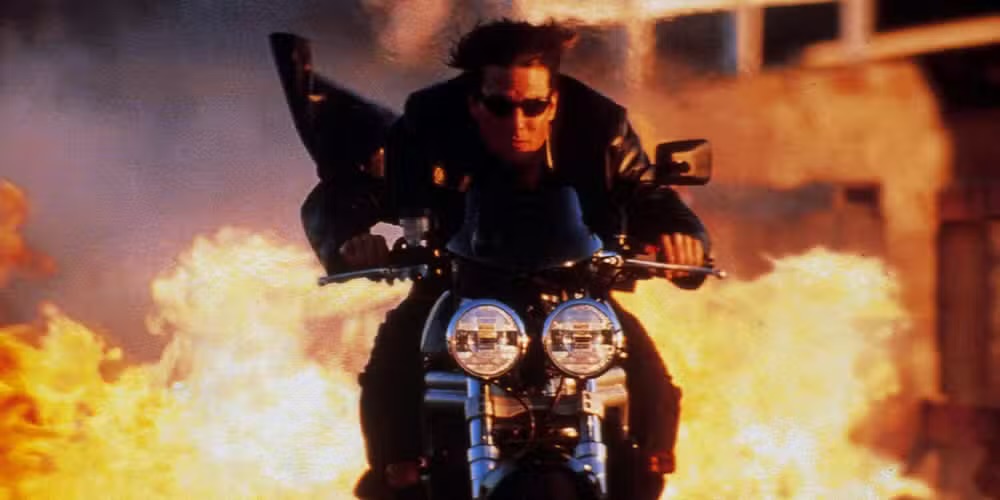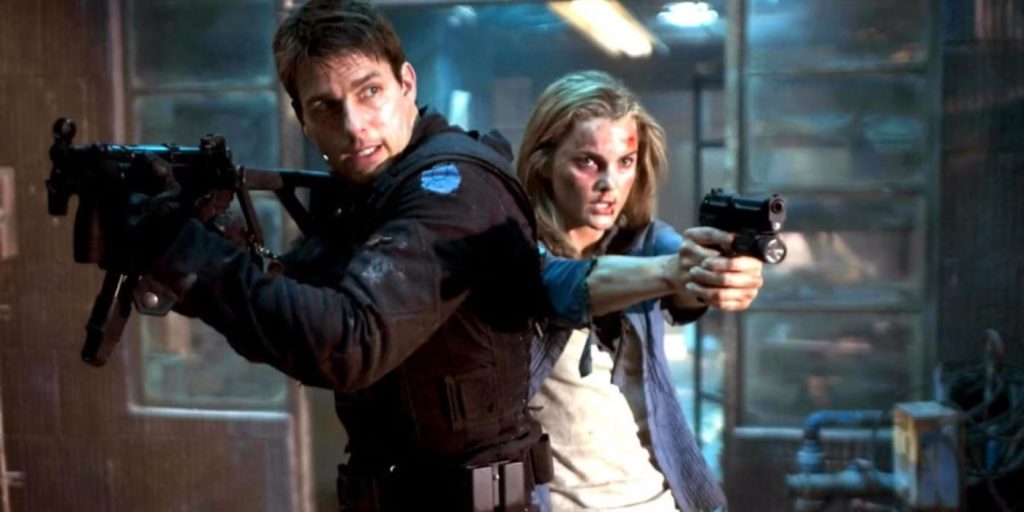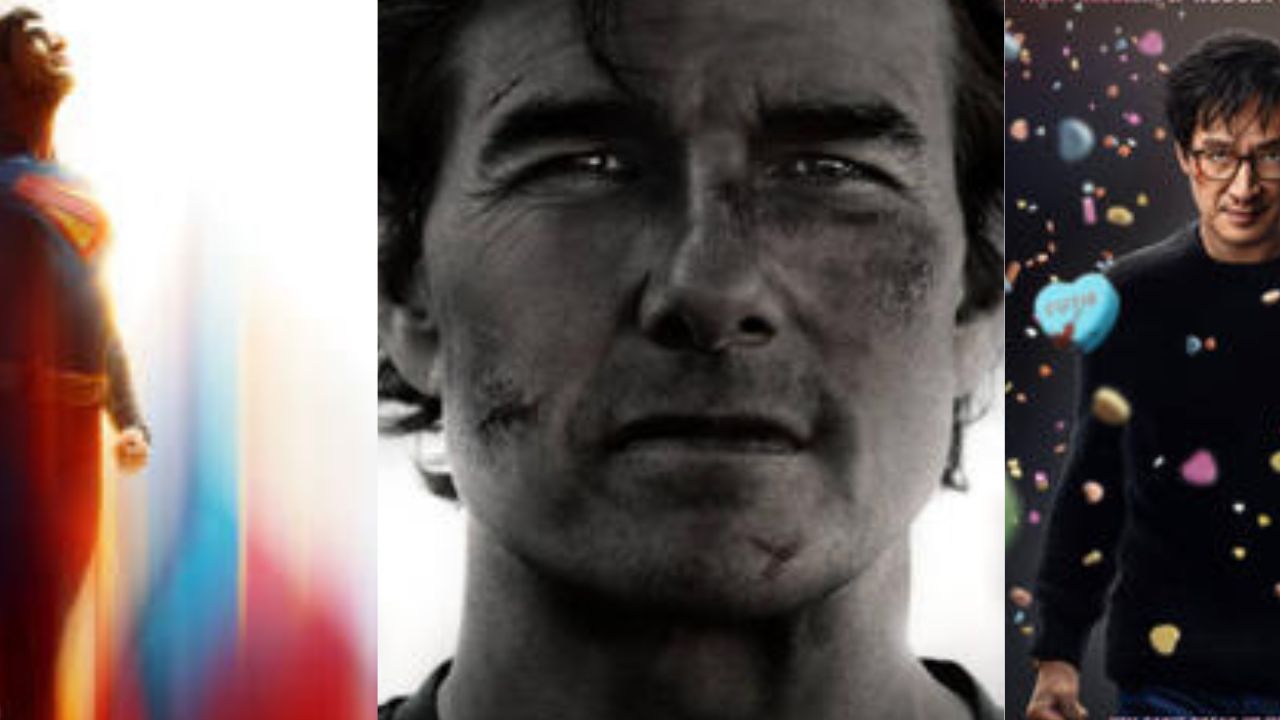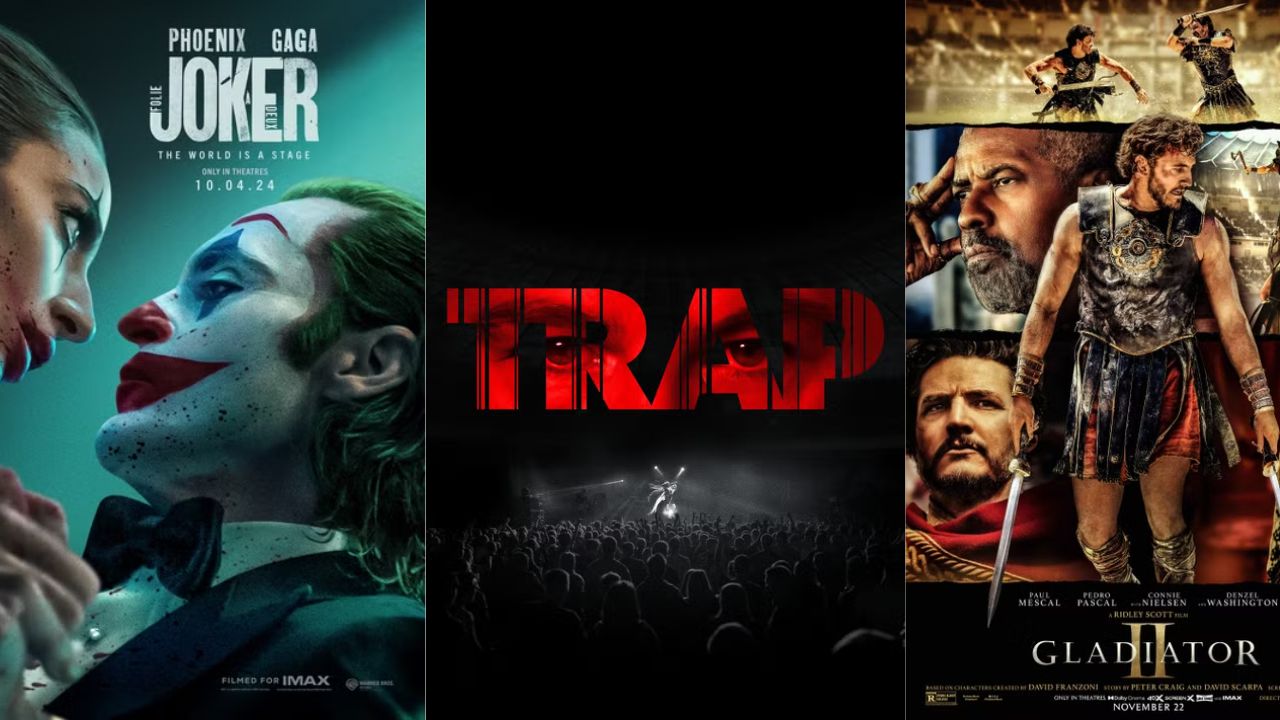Every Mission: Impossible Ranked
Bum-bum-ba-da-bum-bum…
With Mission: Impossible-The Final Reckoning in theaters, naturally it’s time to light the fuse again one last time (well, maybe). Here is my updated ranking of every Mission from worst to best. Even taking into account its low points, this franchise gives us plenty of great action, visceral thrills, and entertainment. If you haven’t seen these films, especially The Final Reckoning, be warned that there will be some spoilers in this ranking. This list will self-destruct in five seconds.
8. Mission: Impossible II

When it comes to this franchise, M:i-2 is widely regarded as the worst one. There is no one reason that this is the black sheep, but instead too many issues. To be fair, John Woo brings his own signature style here, and while that is not inherently a bad thing, it doesn’t exactly lend itself well to these films.
Several memorable stunts and action sequences–especially the opening scene and the climactic motorcycle duel, with one of Tom Cruise most dangerous stunts to date when he almost takes a knife to the eye–are fun to watch. Additionally, Anthony Hopkins’ uncredited cameo as the new IMF director is always enjoyable. And Hugh Jackman was almost cast as the villain, but thankfully Dougray Scott got the part, and so we were blessed with Jackman’s iconic role as Wolverine.
But while this entry is not outright bad, it’s entirely skippable when rewatching the franchise. Woo’s direction is overly-stylized to a fault, with an egregious amount of slow-motion that gives Zack Snyder a run for his money, doves, the melodramatic love triangle, and arguably the most excessive use of those rubber masks. In recent years, Thandiwe Newton has come out and described working with Cruise as “a nightmare”. This sequel marked his first time as producer, and it was the highest-grossing movie of 2000. If this is your weakest movie, you’re actually doing pretty well. But you can look up the best bits on YouTube, and M:i-2 is the only Mission that is just not worth accepting.
7. Mission: Impossible-The Final Reckoning

I should note that there is a sizable gap between my bottom pick and this one. From here on out, the rest of these are ones that I could recommend to some degree. The Final Reckoning is neither a complete failure or a masterpiece, but it is the biggest disappointment in a series that has been consistently good, or even great. For that matter, this film lacks any real sense of finality, feeling like just another adventure for Cruise and Co. while leaving the door open for future installments. What makes it so frustrating is that this movie contains the highest highs and the lowest lows of the franchise.
The good news is that its star, even at 61, still goes that extra mile to entertain fans, providing us with some of the best stunts and action. He continues to cheat death by going underwater (again) and dangling from a plane (again). While we’ve seen these done before in the franchise, they are thrilling and visceral reminders of why we enjoy these films. One connection to the earlier entries works surprisingly well: bringing back Rolf Saxon as William Donloe from the original. Outside of Cruise, other returning cast members–including Henry Czerny, Angela Bassett, Simon Pegg, Ving Rhames, and Hayley Atwell–all do a pretty good job. Luther’s death is actually more effective and emotionally resonant than the untimely, unceremonious demise of Rebecca Ferguson’s Ilsa Faust in Dead Reckoning.
Unfortunately, the script is easily the sloppiest in the franchise, arguably worse than M:i-2. For all of that film’s issues, at least it had a narrative and structure. The first ninety minutes in particular are too preoccupied with indulgent flashbacks to previous installments, and excessive exposition that hurts the pacing. It feels as if the writers are talking down to us, treating us like we don’t understand what is going on. While there is nothing wrong with a few reminders of what came before, The Final Reckoning relies on them too often. A prime example of this is Luther’s subplot: most of it is comprised of flashbacks, leaving precious little screen time for his interactions with Simon Pegg and Cruise here. Past films have always retained a certain sense of fun, but this one is mostly lacking that element. As good an actor as Esai Morales can be, he is simply the weakest villain in the franchise to date, reduced to a one-dimensional, mustache-twirling baddie. Speaking of antagonists, while the Entity was a conceptually a great idea last time, it hardly feels like a threat here, and we are told about its evil plans instead of shown. The romance between Cruise and Atwell feels forced and makes you really miss what previous love interests–especially Ilsa and Julia–brought to the table. While this eighth entry is not bad, it is a missed opportunity, and it takes too long to get to the best parts.
6. Mission: Impossible III

M:i:III is another entry that I always get a good amount of enjoyment out of but come away with a bit of frustration. After multiple viewings, it has risen in my mind. That is due to the introduction of Michelle Monaghan as Julia, who is brought back in later films. The romance between Ethan and Julia is a welcome addition (and it’s nice to see Aaron Paul here, pre-Breaking Bad). For the first time, we see Simon Pegg as Benji.
Of course, what really elevates J.J. Abrams’ directorial debut is the late, great Philip Seymour Hoffman as the deliciously evil Owen Davian. He is easily the best villain in the franchise, full stop. He isn’t some spurned ex-IMF agent or zealot out to destroy the world. Instead, he just wants to make Ethan’s life miserable, and that scene on the plane is the best in this film. The action sequences are generally pretty spectacular: the Vatican infiltration/face-swap and the rescue and tragic death of Keri Russell are also standouts. The traitor twist with Billy Crudup’s Musgrave is also well-executed.
So why this low? Well, Abrams employs his now-famous Mystery Box with the Rabbit’s Foot. Yeah, every Mission has a MacGuffin, but–even in light of The Final Reckoning‘s retcon–it’s so important that Ethan must steal it to trade for Julia’s life. And throughout the rest of the film, everyone is obsessed with knowing what it is. Also, as nice as it is to introduce Julia, that relationship is pretty sidelined in favor of almost non-stop action, and only really comes into focus in the second half. To make matters worse, Abrams’ constant shaky-cam and lens flare is very distracting. Still, M:i:III remains a fairly solid and entertaining ride.
5. Mission: Impossible

In light of what comes later, the 1996 original–based on the TV series of the same name–still holds up surprisingly well. It is unconcerned with the wall-to-wall action and stunts that is synonomous with the franchise by now. The plot is pretty straightforward, too, with some memorable characters like Henry Czerny’s Kittridge and Jon Voight as Jim Phelps. The Langley heist is still iconic and effective all these years later, chock-full of tension. The exploding aquarium scene is another of the franchise’s most memorable stunts. Although the effects are a bit dated, the climactic train fight is also exciting–so much that they replicated it in Dead Reckoning.
Director Brian De Palma lays the foundations for the future, and deserves credit for doing it well. Cruise is up for the challenge, and Ethan Hunt doesn’t even fire a gun until about half an hour in. I would be remiss if I did not mention the reveal of Emmanuelle Béart’s Claire as a villain. Again, it’s a character who is easy to overlook considering everything that comes later.
That said, not everything works as well. The controversial decision to make Phelps the villain certainly did not sit well with some viewers, especially fans of the TV series and actor Peter Graves, whose role as the character in the show was iconic. Also, the plot does get a tad convoluted, and the film is definitely a product of its time. But taken as a whole, this first theatrical Mission is worth accepting.
4. Mission: Impossible-Dead Reckoning

I enjoy many aspects of Dead Reckoning (originally Part One of a two-parter). The callbacks to the original film–including the return of Henry Czerny’s wonderful Kittridge, De Palma’s Dutch angles and close-ups, and even the climactic train fight–are wonderful. The camaraderie between the team, with newcomer Hayley Atwell’s Grace, is still great. Conceptually, the Entity is a nice addition that feels like a threat…even if we’ve seen man vs. AI for decades by now. This installment easily has one of the most thrilling third acts in the series. As always, Cruise delivers crowd-pleasing action and stunts that you would expect from a Mission: Impossible film at this point. Although the bike jump was hyped up too much in the marketing long before Dead Reckoning‘s release, it’s still fun to see, and the derailed train–straight out of Uncharted 2–is a blast.
However, this seventh go-round is plagued by several issues. Starting with Fallout, the franchise reached the point where each movie became needlessly long. The first scene on the Russian submarine would have been best left out or put in the next one, as from the start we already know the answer to the mystery that everyone is racing to solve. In fact, this is only a few minutes shorter than The Final Reckoning, and although Atwell is a nice addition, there is simply too much going on here to give new characters the development that they have received previously. The same goes for Esai Morales’ Gabriel, who is probably the weakest villain in the series.
Furthermore, Rebecca Ferguson’s contract might have expired with this film, but Ilsa (who has by now become my favorite character) still deserved a better send-off than her rather unceremonious, offscreen demise. I understand that the stakes are raised here, but her death still stings and leaves a void that is never filled. The Entity, while timely, is a bit too abstract as an antagonist–requiring multiple scenes of exposition in between the action sequences. This last point is no dealbreaker, but as noted above, we’ve seen the concept of rogue AI in entertainment for decades by now, so it hardly needs too much explanation. All things considered, I still have a good time with this one, despite its flaws.
3. Mission: Impossible-Rogue Nation

These top three are the best examples of Mission: Impossible firing on all cylinders. Cruise’s longtime collaborator Christopher McQuarrie–who did uncredited revisions to the script of Ghost Protocol–steps into the director’s chair and has been there ever since, marking the end of the “revolving door of directors” era. While I do miss that approach in hindsight, Rogue Nation is in many ways a step up in quality. Tom Cruise is predictably reliable as Ethan Hunt, but the supporting cast including Ving Rhames, Simon Pegg, and Jeremy Renner is still strong. The real highlight here is the introduction of Rebbeca Ferguson as the mysterious Ilsa Faust. She easily became a fan-favorite, and the writing of her character is great because unlike the other protagonists, she operates in a grey area despite eventually joining Ethan and his team. Ferguson and Cruise definitely have terrific chemistry and sexual tension for what becomes a romance down the line. Sean Harris’ villain Solomon Lane is not only formidable and creepy, but one of the best antagonists.
The action and stunts are also thrilling and impressive–something that was really established in the predecessor and works like a charm. The standouts include the opening sequence with Cruise dangling from the side of a plane, as well as the underwater heist at the midpoint. In fact, Rogue Nation marks the second time in the series that Ethan dies and is brought back by a woman (first seen in the climax of M:i:III and again in The Final Reckoning). The Vienna opera house fight is another superb and unforgettable action scene.
The only real weakness here is the story, which is a pretty common critique and a valid one. It can be best summed up as “Ethan and Co. go up against an enemy organization known as the Syndicate”. But it gets a bit more complicated and honestly lost in the proceedings. Still, it’s very much worth watching. Here, you come for the action and stay for the intrigue and Ferguson’s performance.
2. Mission: Impossible-Fallout

Widely regarded as the series’ best offering, Fallout marks the first entry that is a direct sequel that requires prior knowledge of the predecessor and other past missions. Also, while you could say this of the previous film, this one is the start of the “plot as a clothesline upon which to hang Cruise’s spectacular stunts and wild action scenes” approach. It is also not just one of the best Mission: Impossible movies, but one of the best in the action genre. Of course, this is why you come to see these, and Fallout delivers energetic, jaw-dropping wall-to-wall action from the start. Henry Cavill is a welcome addition to the cast as the duplicitous August Walker, one of the best villains to date. Returning cast members–Rebecca Ferguson, Ving Rhames, Simon Pegg, and Sean Harris–all contribute something. From start to finish, it’s a wild rollercoaster ride, with one of the best openings yet.
There are so many highlights among the numerous stunts/action sequences here that it becomes, well, impossible to pick a favorite. You get a bathroom brawl, a HALO jump, a convoy hijack, a helicopter duel, and of course the ticking clock countdown as our heroes race to disarm a bomb. Cavill’s appearance is proof that those Justice League reshoots that removed his mustache using CGI were terrible. The high-speed vehicular mayhem, and Tom Cruise breaking his ankle during that rooftop chase and forcing himself to continue only enhance the experience. Solomon Lane returning to target those closest to Ethan cements the villain as a series-best, and we even get unexpectedly moving emotional closure for him and Julia.
At two-and-a-half hours, Fallout is overlong and also marks the point where these films get excessively long, with both Dead Reckoning and The Final Reckoning clocking in at almost three hours. Nevertheless, it’s a fun and engaging ride that should satisfy not just fans of this genre, but hardcore fans of the franchise. It proves for the sixth time that Cruise is completely dedicated to delivering visceral, thrilling action.
1. Mission: Impossible-Ghost Protocol

Both a reboot of the franchise and the last time we see different directors put their signature stamp on each entry, Ghost Protocol manages to be engaging on the action front while retaining a consistent sense of fun. That element is lost in some of the later films, but Brad Bird is more than capable when he helms this one. In fact, this is the first time that the IMF team become fully-realized characters, each with their own sense of purpose and distinct personality. This refreshing aspect enhances them, so that you actually care about them. In this case, Paula Patton, Jeremy Renner, and Simon Pegg–who gets a much bigger role than in M:i:III–all work well with Cruise.
Of course, you can’t talk about this film without mentioning the spectacular action and stunts. This is also the first one to get the IMAX treatment, which makes the famous Burj Khalifa scene even more white-knuckled and vertigo-inducing. Seeing it in this format is not a requirement, even if Cruise and Co. champion this experience for every subsequent Mission. I should also note that while there were impressive stunts in the previous three outings, Ghost Protocol really begins the trend of “Tom Cruise cheating death for our entertainment”. Outside of that memorable set piece, we get the Kremlin infiltration and subsequent bombing, Cruise outrunning a sandstorm, the parking garage fight, and the opening jailbreak. There is an unpredictability here that is absent from the others because the usually-reliable gadgets (including those rubber masks) keep breaking down at the most inconvenient times. This forces the team to improvise constantly. The result is a truly engaging and enjoyable time, and the icing on the cake is that it rewards fans by answering questions about Ethan’s relationship with Julia.
If this fourth film has a weakness, it is the fairly forgettable villain, played by Michael Nyqvist. In fact, Lea Seydoux leaves a much better impression as the assassin that Patton’s Jane is out to kill. Really, coming off the tremendous and frightening performance of Philip Seymour Hoffman last time, it’s something of a letdown. However, it is hardly a dealbreaker, considering that the rest is firing on all cylinders. For all these reasons, it’s the best Mission and it’s definitely worth accepting.




Post Comment